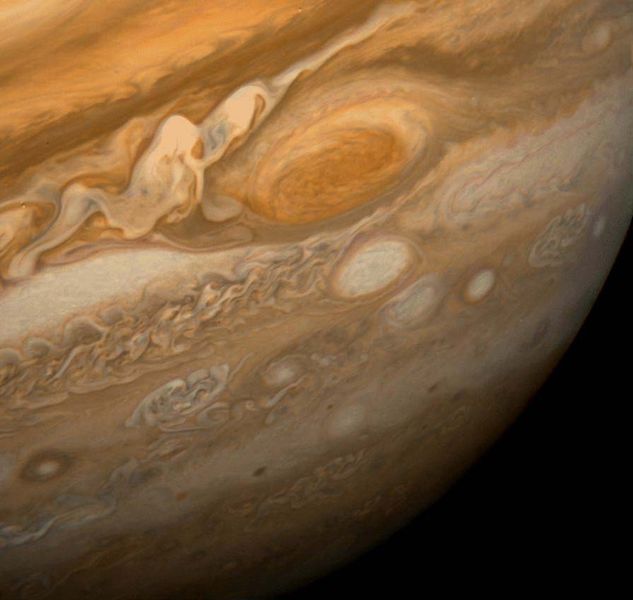Frequently, readers send us questions here on Universe Today. One very good question is ”why does Jupiter have the Great Red Spot?” The short answer is that the Great Red Spot is a storm that has been raging since the 1600s, but a short answer does not tell the whole story. Read on for a much more detailed accounting.
The Great Red Spot (GRS) is an anti-cyclonic(rotates counter-clockwise) storm that is located 22° south of Jupiter’s equator. The storm has lasted an estimated 346 years, but many scientists believe that it is much older. The storm is known to have been larger than 40,000 km in diameter at one time and can be easily seen with large backyard telescopes. Currently it measures approximately 24–40,000 km east–to–west and 12–14,000 km north–to–south. The GRS is large enough to envelope two to three Earths. Despite the GRS’s enormous size, it is shrinking. In 2004, it had about half the longitudinal size that it had a century ago. Some scientist estimate that if it continues to shrink at its current rate, it could become circular by 2040. A study by scientists at the University of California, Berkeley showed that the GRS lost 15 percent of its diameter along its major axis between 1996 and 2006. Xylar Asay-Davis, a team member on the study, noted that the spot is not disappearing because ”[v]elocity is a more robust measurement because the clouds associated with the Red Spot are also strongly influenced by numerous other phenomena in the surrounding atmosphere.”
Infrared data indicates that the GRS is colder and located at a higher altitude than most of Jupiter’s other clouds. The cloudtops of the GRS are about 8 km above the surrounding clouds. The storm is held in place by an eastward jetstream to its south and a very strong westward jetstream to its north. Winds around the edge of the GRS peak at 432 km/h, but winds within the storm seem to nearly none existent, with little inflow or outflow. In 2010, astronomers imaged the GRS in the far infrared and found that its central(reddest) region is warmer than its surroundings by about 4 K. The warm airmass is located in the upper troposphere. This warm central spot slowly rotates in the opposite direction of the remainder of the storm and could be a remnant of air flow in the center.
Alright, so why is the storm red? The exact cause of the coloring has not been proven, but…lab experiments support the theory that the color is caused by complex organic molecules, red phosphorus, or another sulfur compound that are pulled from deeper within Jupiter. The color of the GRS varies. At times it is brick-red, fading to a pale salmon, and even white. The spot occasionally disappears from the visible spectrum and can only be seen as the Red Spot Hollow; its niche in the South Equatorial Belt(SEB). The visibility of GRS is apparently coupled to the appearance of the SEB. If the SEB is bright white, the spot tends to be dark. When it is dark, the GRS is usually light. The periods that the color changes last and occur on an unpredictable schedule.
As you can see, the answer to ”why does Jupiter have the Great Red Spot?” has been well researched by NASA and other space agencies. While the answer is not crystal clear at this time, future missions to the planet are designed to better study the atmosphere; hopefully, rendering the answers scientists seek.
We have written many articles about Jupiter for Universe Today. Here are some interesting facts about Jupiter, and here’s an article about the color of Jupiter.
If you’d like more information on Jupiter, check out Hubblesite’s News Releases about Jupiter, and here’s a link to NASA’s Solar System Exploration Guide to Jupiter.
We’ve also recorded an episode of Astronomy Cast just about Jupiter. Listen here, Episode 56: Jupiter.
Sources:
http://www.nasa.gov/multimedia/imagegallery/image_feature_413.html
http://www.nasa.gov/centers/goddard/news/topstory/2006/little_red_spot.html

